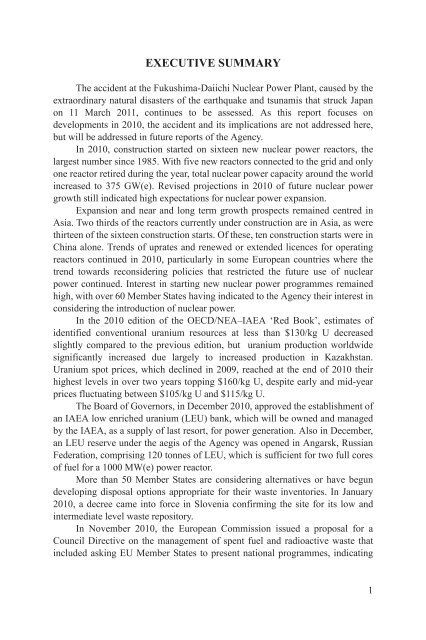Nuclear Technology Review 2011 - IAEA
Nuclear Technology Review 2011 - IAEA
Nuclear Technology Review 2011 - IAEA
Create successful ePaper yourself
Turn your PDF publications into a flip-book with our unique Google optimized e-Paper software.
EXECUTIVE SUMMARY<br />
The accident at the Fukushima-Daiichi <strong>Nuclear</strong> Power Plant, caused by the<br />
extraordinary natural disasters of the earthquake and tsunamis that struck Japan<br />
on 11 March <strong>2011</strong>, continues to be assessed. As this report focuses on<br />
developments in 2010, the accident and its implications are not addressed here,<br />
but will be addressed in future reports of the Agency.<br />
In 2010, construction started on sixteen new nuclear power reactors, the<br />
largest number since 1985. With five new reactors connected to the grid and only<br />
one reactor retired during the year, total nuclear power capacity around the world<br />
increased to 375 GW(e). Revised projections in 2010 of future nuclear power<br />
growth still indicated high expectations for nuclear power expansion.<br />
Expansion and near and long term growth prospects remained centred in<br />
Asia. Two thirds of the reactors currently under construction are in Asia, as were<br />
thirteen of the sixteen construction starts. Of these, ten construction starts were in<br />
China alone. Trends of uprates and renewed or extended licences for operating<br />
reactors continued in 2010, particularly in some European countries where the<br />
trend towards reconsidering policies that restricted the future use of nuclear<br />
power continued. Interest in starting new nuclear power programmes remained<br />
high, with over 60 Member States having indicated to the Agency their interest in<br />
considering the introduction of nuclear power.<br />
In the 2010 edition of the OECD/NEA–<strong>IAEA</strong> ‘Red Book’, estimates of<br />
identified conventional uranium resources at less than $130/kg U decreased<br />
slightly compared to the previous edition, but uranium production worldwide<br />
significantly increased due largely to increased production in Kazakhstan.<br />
Uranium spot prices, which declined in 2009, reached at the end of 2010 their<br />
highest levels in over two years topping $160/kg U, despite early and mid-year<br />
prices fluctuating between $105/kg U and $115/kg U.<br />
The Board of Governors, in December 2010, approved the establishment of<br />
an <strong>IAEA</strong> low enriched uranium (LEU) bank, which will be owned and managed<br />
by the <strong>IAEA</strong>, as a supply of last resort, for power generation. Also in December,<br />
an LEU reserve under the aegis of the Agency was opened in Angarsk, Russian<br />
Federation, comprising 120 tonnes of LEU, which is sufficient for two full cores<br />
of fuel for a 1000 MW(e) power reactor.<br />
More than 50 Member States are considering alternatives or have begun<br />
developing disposal options appropriate for their waste inventories. In January<br />
2010, a decree came into force in Slovenia confirming the site for its low and<br />
intermediate level waste repository.<br />
In November 2010, the European Commission issued a proposal for a<br />
Council Directive on the management of spent fuel and radioactive waste that<br />
included asking EU Member States to present national programmes, indicating<br />
1

















